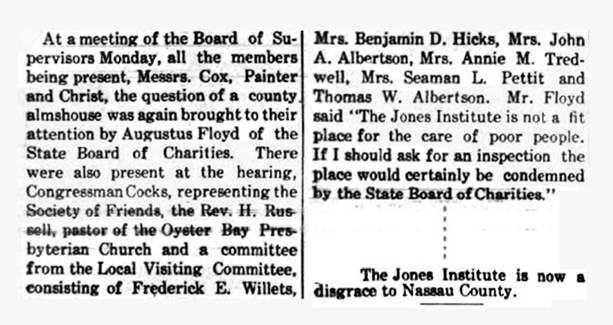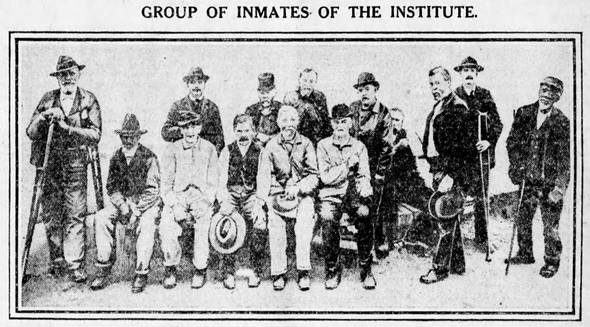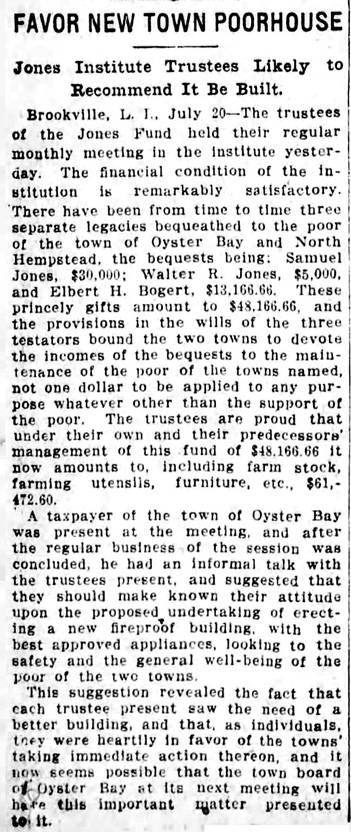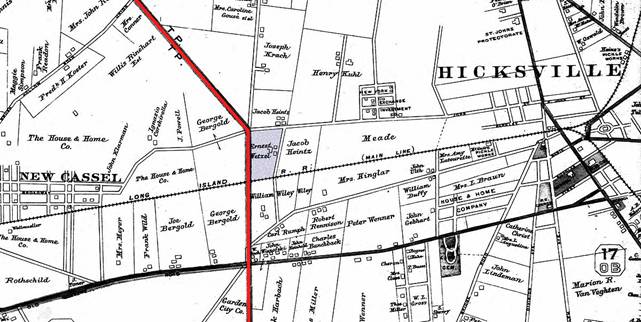
Last month, we saw how the Protectory sheltered boys in need, and helped them prepare for their futures. As the excerpt above suggests, however, Long Islanders have not always treated their needy neighbors very well. This month, we look at the complicated history of the Jones Institute, a local residence that cared for adults in need. Its origins can be traced back to early 1836, but we'll set the stage here by beginning the story a little earlier.
The tale is an old one. Within any given society, there are people who are not self-sufficient, people who need help in order to survive. Historically, societies generally have tried to help them - although more often, they really tried instead to "deal with the problem of poverty." Sometimes, governments assumed that most poor people simply don't want to work - and then implemented a one-size-fits-all approach, putting paupers into workhouses and poor farms, so that they might "learn how to help themselves" and pay their own way.
Thus, in 1818, before there was a Hicksville, the fine people of North Hempstead came up with the idea of leasing their impoverished neighbors to the lowest bidder, who would both "care for them" and use them as laborers for his or her personal gain. Not everyone thought this was wise or moral; indeed, a number of people protested that this "solution" reeked of slavery. Nonetheless, the plan was put into action.
***
Samuel Jones
Let's fast forward from 1818 to February 1836. Samuel Jones, former Chancellor of the State of New York, and prominent resident of Oyster Bay, realizes that his health is failing. As he sets about putting his affairs in order, his mind dwells upon the problem of how to better provide for the local poor. Jones himself is wealthy, but most of his fellow townsmen are not. They are burdened by a number of taxes, including a poor tax that seems not to accomplish very much. No one, not even he, believes that an answer will be found by simply increasing taxes. Samuel Jones thinks he has a better idea, and he writes his will accordingly.
*
He died that May, and come August, his will was probated. To widespread surprise, his will provided $30,000 (equivalent to more than $900,000 in today's dollars) for the establishment of The Jones Fund for the Support of the Poor. It was an enduring trust fund, the interest from which was to fund a residence that was open to any impoverished resident of the Town of North Hempstead or the Town of Oyster Bay. Many townspeople were not pleased to learn of Jones's bequest - it was met with suspicion, and likely with a good measure of NIMBYism to boot.

W.W. Munsell and Company, History of Queens County, New York,
published 1882
Samuel Jones's idea had evolved from the old poor house / work farm concept: the poor would live in a residence in an agricultural setting, and they would tend the fields. The significant (and perhaps naive) difference in his plan was that taxpayers would not be burdened. All expenses were to be paid by interest generated from the Jones Fund, and secondarily by revenue created through the sale of the produce that the residents harvested. Note the similarity of this approach to that followed years later by the Protectory, where the boys' labors successfully reduced the burden of charitable donations needed to keep their home going.
Within months, on farmland somewhere near the boundary between Brookville and Muttontown, a group of impoverished residents - sometimes called "inmates" - were sheltered for the winter, and the Fund's money had been invested safely.
***
Ready...Set...Oops!
Alas, any planning assumptions made in 1836 were thwarted by the nationwide Panic of 1837. The prolonged economic crisis led to a number of disastrous results, including the LIRR's stopping construction of the railroad where things were, and thereby unintentionally founding Hicksville.
For the Oyster Bay and North Hempstead Town Almshouse, as it was then called, the market crash was fatal - if not to the farm itself, then to Samuel Jones's plan that it would forever survive without tax support. For it to do that, the Jones Fund's investments would have to earn regular income. The money had been invested quite conservatively, much of it in Brooklyn real estate. Those investments would generate a steady stream of revenue as the Fund's tenants made their rental and lease payments.
The panic, however, was both sudden and severe. Individual tenants soon lost their jobs, and corporate tenants quickly went bankrupt. Income from real estate holdings was at best a pittance. There was no recourse; the trust would have to weather the panic, paying what little it could to keep the Almshouse residence going. Within a year, the Towns had to start funding its deficits. From time to time, private individuals, including some members of the Jones family, added to the Fund's capital in order to keep it afloat.
Things gradually stabilized, but public assistance would almost always be needed after that. The Towns continued to provide funding, as doing that was cheaper than letting the trust fail. If the latter had happened, taxpayers would have had to assume the full burden of housing and caring for the poor.
*
As the Civil War ran its course, so did the trickle of disabled veterans who found their way home to Long Island. For the North, the most visible badge of its victory would be a crop of maimed young men who had served their country - many of whom would always remain unfit for work. Perhaps this was why, in 1866, Albany authorized the two Towns to construct a new residence in Brookville, to furnish it, and to build the requisite ancillary buildings for the farm.

The 1866 residence, the first to be called the Jones Institute, in Brookville, New York
The Brooklyn Daily Eagle, December 3, 1910
*
People came and went at the residence, but there was one constant: most of them were not able-bodied - which was, of course, probably the reason they were poor. The following report quantifies some facts, as well as offering a glimpse into life at the Institute. Conventional wisdom, i.e., that the lazy but able-bodied poor could support paupers' homes, does not stand up to scrutiny in light of this objective assessment of the inmates.

The Newtown Register, November 5, 1885
***
What to Do?
Despite taxpayer assistance, conditions at the Brookville residence generally fell short of what Samuel Jones had envisaged. Moreover, with no reliable surplus for capital improvements, the 1866 home could not keep up with the rapidly changing times. As late as July 1899, it had no running water, and no wells. For purposes of drinking, cooking, and sanitation, the residents - at that point, the total number fluctuated between 100 and 125 - had to transport barrels of untreated pond water (!) across the property. That year, State inspectors ordered that proper plumbing and bath facilities be built for the residents. Some taxpayers grumbled at having to pay for this effort to make the inmate's living conditions a little less sub-standard.
By the turn of the twentieth century, everyone knew that life in the old residence was already intolerable, and it was getting worse.
The Hempstead Sentinel
September 15, 1910

It was supposed to be all about them.
The Brooklyn Daily Eagle, December 3, 1910
As the laments and complaints continued to appear in the press, people finally began to consider making a change.

The Brooklyn Daily Eagle, November 21, 1909

The Brooklyn Daily Eagle, July 20, 1911
*
In hindsight, it took a remarkably long time for the situation to be resolved. In part, the lack of expediency may have been due to the public's poor understanding of the legal framework within which the Jones Fund functioned. Well-intended citizens and officials often put forth suggestions, some of which seemed excellent - except insofar as they were in conflict with that fundamental framework. For example, the Town Supervisors could not simply create a new policy, or divert funds to address a problem. Although the Institute reached a point at which taxes were its primary source of income, the managers of the Jones Fund governed policy, and even their hands were tied in some ways. The constraints written into Samuel Jones's will, and afterwards enshrined by the State of New York, were practically immutable. Good Mr. Jones had died slowly, and he had had plenty of time to think things through.
Please see the Appendix to this article for additional thoughts on this topic.
***
To Hicksville
Eventually, everyone involved - the Towns, various members of the Jones family, the managers of the trust, and Albany - agreed upon a course of action: farmland in the Hicksville area would become the site of a new Jones Institute, and the Brookville property would be sold. Each Town provided $30,000 - ironically, the same amount as the original bequest - for the purchase.
The farm that was chosen had long been owned by Ernest Witzel and his wife Augusta. Around 1900, after running a milk business for many years, Witzel had given up that business in favor of farming full-time. Several years afterwards, he died suddenly. His widow eventually remarried, after which she sold her 25 acres of farmland to the Fund.
Site Chosen for the Jones Institute in Hicksville
Note that Ernest Witzel's name is misspelled on the map.
The red line marks the border between the
Townships of North Hempstead and Oyster Bay.
E. Belcher-Hyde, Atlas of Nassau County, NY, 1906
By the spring of 1915, the end of construction was in sight. As the sale of the Brookville property realized $65,000, substantially more than anticipated, an unplanned surplus remained in the building fund.

The Brooklyn Daily Eagle, September 16, 1915
The new red-brick structure was both graceful and imposing. There was plumbing(!), all the rooms let in sunlight and fresh air, it was only two stories tall (much to the delight of the residents' well-worn knees), and residents never had use a staircase to reach a bathroom. In addition, the home had its own on-site hospital. The 38 inmates were able to leave Brookville behind in August.
A frustrating financial crisis arose a few days before Christmas was first celebrated at the new home. The Eagle reported that the Institute found itself $4,000 in the red (one presumes that expenses had been harder to predict and control during the transition between the old and new facilities). The "unnecessary" surplus remained in the building fund, but it could not simply be re-purposed to pay an operating deficit. The situation was further complicated by the well-intentioned "strings" which the Towns had attached to their combined $60,000 contribution; one might even argue that their contribution was the source of the surplus. I have not found any report that details the manner in which the problem was resolved, but it evidently took time to devise a legal solution.
*
A curious situation arose in 1918: the Unincorporated Village of Glen Cove seceded from the Town of Oyster Bay to become the Incorporated City of Glen Cove. Its residents opted to remain part of the Jones Institute arrangement, and to continue provide tax support for it.
"Two Towns" had become "Two Towns and a City."
***
Better
Over all, the years that followed the move to Hicksville appear to have been much better for the residents than the preceding decades. Their home made the news less often, because no one was threatening to condemn the buildings, or calling them unsuitable, or calling the Institute wasteful, or predicting that it would go bankrupt.
In September 1926, the annual report on County institutions found that the Jones Institute was well managed, as was its hospital. The report also noted that for the date of the visit (probably in August or very early September) the home once again had 38 residents, more than was customary for the season. Perhaps this meant that farmers had hired fewer hands than usual that summer - if that was so, it might be a symptom of the incursion of more housing plots into traditional farmland.
Judging by the January 6, 1928 issue of the weekly Long-Islander, the people of Hicksville had embraced the Jones Institute. The paper's Hicksville column included a letter of thanks from the residents. It expressed warm appreciation for the Christmas visit of the Walter Wheeler Council of the Junior Order of United American Mechanics (a fraternal order of - don't be misled by its name - adults; the local Council was named after one of Hicksville's WW I dead). The group had brought gifts to the residents, as well as providing "excellent Yuletide entertainment."
The same column noted that on the following Sunday, the local Epworth League (an organization for young Methodists) was going to arrive at the home with a busload of people, to conduct a "song service."
All in all, newspaper coverage during these years suggests that life in the new Institute was far less gloomy than life in the old.
*
In 1940, an inmate passed away. He had arrived at the home in 1933, which for much of America was the extreme height (or depth) of the Great Depression. Like all the residents, before arriving, he had been found to be indigent, based upon all the information that was known about him.
Early in 1941, his will was probated, at which point it became known that he had maintained an undisclosed bank account with a balance of about $8,000. Thus, in violation of the home's rules, he had never been legally indigent. The lawyers of the "Two Towns and a City" took his estate to court, intending to recover the costs of having maintained and housed him for seven years.
Spoiler Alert: I have not been able to determine how things were resolved.
***
The Downward Glide
For a while, the Jones Institute was able to adapt to the evolving twentieth century "social landscape" of Long Island and the nation. With the advent of Social Security, the residents' benefit payments were added to the funding mix; later, payments from the Nassau County Department of Social Services also were added. By the 1970s, however, other demands on the County's purse led to the latter being discontinued. Instead, residents received smaller payments of Supplemental Security Income. In addition, after 60 years, the aging structure had become increasingly expensive to maintain.
The operational deficit grew steadily, and as things stood, the Institute appeared to no longer be viable. The Fund began to consider its options, including the possibility of shuttering the facility. Things were effectively decided when the Fund received a generous unexpected offer for the Hicksville property, from a business that was willing to pay significantly more than market value. The Fund believed that an immediate sale at that price would allow it to promptly re-establish the Institute in a new building elsewhere.
Ironically, news of the pending sale triggered a legal action on behalf of the 55 current residents, who did not wish to move. Things dragged on, and the would-be purchaser lost confidence in being able to own the site by the time it was required. The deficit kept growing, until part of the property was sold, and the proceeds were used to clear the increased accumulated debt. With too little time, and too little money in the Fund to quickly replace the Institute, the residents were transferred to a number of other locations, the empty home was closed in 1980, and the remaining property was sold.
Samuel Jones's idea had finally died - well, almost.
***
Life After Life
The proceeds from the final sale allowed the Fund purchased a building at Bayville. It would be a very different type of facility - there would be no fields to farm. After undergoing renovation, it became Jones Manor on The Sound, a home for 46 residents. It was operated by the Fund for more than thirty years, until it closed in 2015.

The Northport Observer, December 12,1991
Readers interested in learning more about the Jones Institute should contact the Oyster Bay Historical Society. To get an idea of the relevant materials it holds, they can read and/or download this summary of its holdings:
https://www.oysterbayhistorical.org/uploads/4/9/5/1/4951065/jones_fund_for_the_support_of_the_poor.pdf
***
Appendix
What first comes to mind when someone mentions the year 1836? For me, it's the Battle of the Alamo, but never mind. Forget the Alamo, so to speak.
If you're reading this, you definitely should remember that Samuel Jones wrote his will in 1836. If you have also read last month's article, you might recall that the Roman Catholic Orphan Asylum Society of Brooklyn was founded around that time (precisely when it was founded seems difficult to determine; I've seen both 1836 and 1838 given as the year). If you majored in English Literature, you may know that in 1836, Charles Dickens was preparing the chapters of Oliver Twist for serial publication. The first chapter would be published in February 1837.
What do these three things have in common? All of them reflect something about the 1830s, an era that witnessed a groundswell of social reform in English-speaking society, specifically with regard to the victimization of the poor, whether children or otherwise.
Dickens was just starting his dual careers as an author and social activist. Oliver Twist was the first salvo he would fire in his war against the hypocrites who ran orphanages and schools for personal gain, pretending to shelter and protect the children they often abused. Brooklyn's Orphan Asylum Society was completely in step with him.
Samuel Jones? He, too, concerned himself with needy people, albeit primarily those who were nearing the other end of life. He wanted them to have what we today call "dignity and respect" - as well as clean beds, food for their bellies, and good health. But he also recognized that evil and temptation can arise when one is the custodian of funds intended to help the poor. Jones built safeguards into his legacy, rules that had to be followed, rules that prevented the diversion of charitable donations into the pockets of those who someday would operate the Jones Institute.
Looking back at what Jones wrought, I am surprised by the fact that it survived so long - no, not because I think that it had some inherent fatal flaw. Rather, I am surprised because it was dropped newly-born into a young, fast-growing, and fast-changing country, and at the worst possible time. It never got the chance to function without taxpayer support, but it adapted as well as it could, and it survived, even as America kept changing at a hectic pace. By the end, the Jones Fund had housed and looked after poor people, without profit, for almost 180 years.
Despite the Fund's ultimate demise, I suspect that Mr. Jones would feel very good if he knew how far his $30,000 went.
*****

